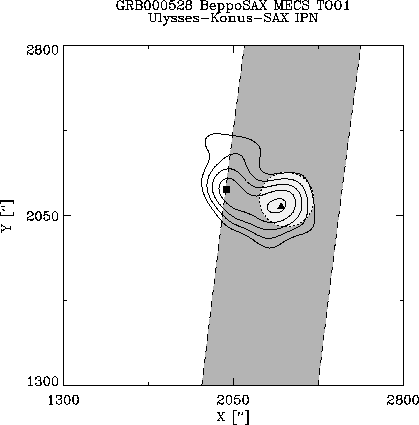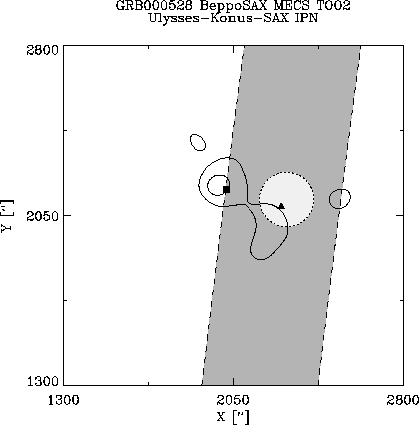
Gamma-ray Burst 000528

A GRB was detected on May 28, 2000 at 08:46:35 UT with
BeppoSAX, Ulysses and NEAR, and localized to better than 2 armin.
(All information courtesy of the instrument teams.)
 Previous IAU Circulars
Previous IAU Circulars
 Results of Observations
Results of Observations
- BeppoSAX mail n.00/10
On May 28 at 08:46:35 UT a strong and long burst (GRB000528) was detected
by GRBM and WFC2 (2-26 keV).
The position is:
R.A.= 161.354
Decl.= -34.002
with an error radius of 4'.
The follow-on is technically feasible, but the unavailability of Mission
Planners during Sunday and the switching-off of instruments during weekend
nights doesn't allow a useful and fast repointing of satellite (see GCN
634).
- BeppoSAX MAIL n. 00/11
Refined coordinates from WFC are:
R.A.(2000)= 161.276
DEC(2000)= -33.983
i.e. 4' off from the preliminary position.
The error radius is 2'.
Thanks to BeppoSAX staff personal efforts we are planning a NFI
follow-on, with the instruments switched on during the whole night.
- GCN notice #674
B. L. Jensen, J. Hjorth, H. Pedersen (University of Copenhagen),
J. Gorosabel (DSRI), J. A. L. Aguerri (IAC), and A. A. Kaas (NOT)
report on behalf of a larger European collaboration:
We have imaged the error circle of GRB 000528 (Piro & Gandolfi, BeppoSAX Mail
## 00/10, 00/11) with the 2.5-m Nordic Optical Telescope. Two 300-s R-band
exposures were obtained with ALFOSC on 28.90 May 2000 UT. The data were
obtained at high (2.7) airmass but in fairly good seeing (1.4" FWHM) and
reach a limiting magnitude of about R = 22.3. No obvious candidate optical
counterpart to GRB 000528 is found down to a limit of R ~ 21.5 by comparison
with the Digitized Sky Survey (DSS-2, AAO SES red). The NOT image is posted at
http://www.astro.ku.dk/~brian_j/grb/grb000528/ .
- GCN notice #675
C. Guidorzi, E. Montanari, F. Frontera (Department of Physics,
University of Ferrara, Italy) and M. Feroci (IAS/CNR, Rome) on behalf of
a larger collaboration report:
With reference to the GRB000528 occurred on May 28.366 UT and localized
with the BeppoSAX WFC no. 2 (see BeppoSAX Mails ## 00/10 and 00/11), a
preliminary analysis of the GRBM data shows a complex time profile of
this GRB with two main peaks of decreasing intensity. The peak flux is of
1.7E3 cts/s in the 40-700 keV energy band corresponding to
1.44 +/- 0.04) x 10^(-6) erg/cm2/s . The GRB duration is of about 80 s.
A preliminary spectral analysis reveals an evident softening evolution
with an average power law photon index of about 1.9.
We are now able to derive rough GRB positions from the GRBM data. The GRBM
position obtained for this GRB is R.A.(2000)= 160 and DEC(2000) = -29 with
an error radius of 5 deg, that is fully consistent with that given with
the WFC.
- GCN notice #677
J. in 't Zand and J. Heise, Space Research Organization of the
Netherlands (SRON), Utrecht; E. Kuulkers, SRON and Astronomical Institute,
Utrecht University; G. D'Andreta and G. Celidonio, BeppoSAX Science
Operations Center, Telespazio, Rome; J.M. Muller, SRON and BeppoSAX Science
Data Center, Telespazio, Rome; G. Gandolfi and E. Costa, Istituto di
Astrofisica Spaziale, CNR, Rome; and F. Frontera, Istituto Tecnologie e
Studio Radiazioni Extraterrestri, Bologna, report: "GRB 000528, which was
detected by the BeppoSAX Gamma-Ray Burst Monitor on May 28.366 UT (GCN Circ.
675), was simultaneously detected with Wide Field Camera (WFC) unit 2. While
the burst lasted for about 80 s in gamma-rays (40-700 keV), it lasted about
120 s in x-rays (2-26 keV). The WFC-determined position is R.A. = 10h45m06.3s,
Decl. = -33o58'59" (equinox 2000.0), with an error radius of 2' (99-percent
confidence level). The 2-26 keV peak flux is 1.9 Crab units.
- GCN notice #681
K. Hurley, on behalf of the Ulysses GRB team, T. Cline and
E. Mazets, on behalf of the Konus-Wind GRB team, and F. Frontera,
C. Guidorzi, and E. Montanari, on behalf of the BeppoSAX GRBM
team, report:
Ulysses, Konus, and the BeppoSAX GRBM observed this burst (GCN #677).
Triangulation gives a preliminary annulus centered at RA(2000)=129.532,
Decl.(2000)=-33.150, with radius 26.478 +/- 0.111 degr. (3 sigma).
This annulus intersects the BeppoSAX WFC error circle at two points
(RA, Decl.=161.292, -34.013, and RA, Decl.=161.283, -33.950), reducing
its area by over a factor of two. A map has been posted at
ssl.berkeley.edu/ipn3/000528. This localization can be improved.
In addition, we call attention to the fact that the Ulysses data
clearly show a second episode of emission which follows the burst by
~600 seconds, with intensity approximately as great as that in the
burst itself. It is possible that this is from the same source as the
burst; we are investigating whether the Konus or GRBM data can be used
to verify this. The time history has been posted at the same site.
- GCN notice #683
A BeppoSAX follow up of GRB000528 with the Narrow Field Instruments
started around May 28 at 20:50 UT, i.e. about 12 hours after the GRB.
Preliminary analysis of the MECS (1.6-10 keV) data shows
two previously unknown sources inside the field. The preliminary WFC error
box (BeppoSAX Mail #10) contains both objects, while the refined one
(BeppoSAX Mail #11 and GCN 677) only the second.
Object #1:
R.A.(2000)= 161.365
DEC(2000)= -33.975
Object #2:
R.A.(2000)= 161.287
DEC(2000)= -33.986
both with an error radius of 1.5'.
The source #1 is possibly fading, while the #2 seems to be consistent with
a constant flux. Further and more detailed analysis are in progress.
- GCN notice #686
E. Berger (Caltech) and D. A. Frail (NRAO) report on behalf of a
larger collaboration:
On June 1.11 UT we used the VLA at 8.46 GHz to observe the field centered
on the refined position provided by the SAX WFC (GCN 677). There are no
obvious radio candidates brighter than 0.14 mJy (3.5 sigma) inside the
1.5' region centered on object #2, which was identified by the SAX NFI
(GCN 683). The 1.5' region centered on object #1 contains one bright
source which is also present in the NRAO VLA Sky Survey (NVSS). Further
observations are planned.
- GCN notice #691
E. Palazzi, N. Masetti, E. Pian, F. Frontera (ITESRE, CNR, Bologna),
A.J. Castro-Tirado (LAEFF, IAA), J. Hjorth (Univ. of Copenhagen),
P.M. Vreeswijk, E.P.J. van den Heuvel (Univ. of Amsterdam),
J. Greiner (AIP), P. Francois, J. Brewer and O. Hainaut (ESO)
and L. Piro (IAS, CNR, Rome), on behalf of a larger collaboration,
report:
We obtained optical R-band images of the field of GRB000528 (BeppoSAX
Mails #00/10, #00/11) on 2000 May 29.10, May 29.96 and June 4.02 UT (i.e.
18 hr, 38 hr and 160 hr after the GRB, respectively) with the 1.54-meter
Danish telescope (plus DFOSC) at ESO - La Silla (Chile).
These images contain the BeppoSAX WFC error box of this GRB (GCNs #677,
#681) and the two MECS sources reported in GCN #683. Seeing was
~1.3 arcsec on the three epochs. Exposure times were 15 min for the first
observation, 10 min for the second and 45 min for the third.
Photometric calibration was performed using standard stars in the Landolt
field SA107 (Landolt 1992, AJ 104, 340). The comparison between pairs of
images does not reveal any object with significant brightness variation
down to a 3-sigma limiting magnitude of R ~ 23.3.
- GCN notice #700
E. Kuulkers, L. Kuiper, J.J.M. in 't Zand, J. Heise (Space Research
Organization Netherlands), L.A. Antonelli (Osservatorio Astronomico di Roma),
K. Hurley (University of California, Berkeley), L. Salotti (ASI, Rome),
M. Stornelli, G. Celidonio (Telespazio, Rome), E. Costa, M. Feroci,
G. Gandolfi (IAS-CNR, Rome), F. Frontera (ITESRE-CNR, Bologna, and University
of Ferrara) L. Nicastro (IFCAI-CNR, Palermo), T. Cline (NASA Goddard Space
Flight Center), E Mazets (Ioffe Physici-Technical Institute, St. Petersburg),
C. Guidorzi, and E. Montanari (University of Ferrara) report:
The BeppoSAX narrow-field instruments observed the region of GRB000528 twice:
from May 28.71 to May 29.57 UT (TOO1, 8.3-28.9 hours after the burst) and
from May 31.65 to June 1.49 (TOO2). The total exposure time obtained with
the Medium-Energy Concentrator Spectrometers (MECS) is 58 ksec. Two X-ray
sources close to one another were detected in the field, one at
R.A. = 10h 45h 28m, Dec. = -33d 58' 14" (J2000.0), which we designate as
1SAX J1045.5-3358 (object 1 in GCN 683), and the other at R.A. = 10h 45m 08s,
Dec. = -33d 59' 26", which we designate as 1SAX J1045.1-3359 (object 2 in GCN
683). Both sources have a conservative positional error of 1.5'. Object 2 is
inside the WFC error region (GCN 677) while the centroid of object 1 is 2.5
arcmin outside that region. We note that a bright and archival radio source
has been reported coincident with object 1 (GCN 686). A refined IPN analysis
using Ulysses, BeppoSAX, and Konus data indicates that object 1 is far less
consistent with the IPN annuli than object 2. The countrates for object 1
in MECS units 2 and 3 combined are (2.10+/-0.44)E-3 and (1.21+/-0.36)E-3 c/s
for TOO1 and TOO2 respectively and for object 2 (2.40+/-0.46)E-3 and
(0.65+/-0.32)E-3 c/s. Object 2 shows the strongest fading. Based on all
pieces of information, we identify object 2 (1SAX J1045.1-3359) as the
likely X-ray afterglow of GRB 000528.
For maps of the error regions, see URL
http://wfc.sron.nl/GRB000528/
Contour maps of source detection significances in he MECS 2-10 keV data for
TOO1 (26.6 ks exposure, upper map) and TOO2 (31.2 ks, lower map). The contours
start at 3sigma and go up in steps of 1sigma. The two axes are in instrument
coordinates (in units of arcsec). The dark-shaded area designates the overlap
between the refined
Ulysses/BeppoSAX annulus and the Ulysses/Konus annulus, the light-shaded
circle inside this area is the WFC error region. The positions of
the two sources were determined using TOO1 and are indicated by
the square (object 1) and triangle (object 2). Object 1 is coincident with
an archival radio source (GCN 686) and is apparent in both TOOs.
Object 2 is not present in TOO2 and is the proposed X-ray afterglow.
Neither the WFC nor the GRBM observed the delayed emission 600 s after
the burst (GCN 681); the source was unocculted at this time, and this
emission would have been detected with high significance if it had
originated from this source. We conclude that this emission was either
solar in origin, or possibly from a different GRB.
Back to JG's
homepage
Jochen Greiner, last update: 14-Jun-2000
[Disclaimer]
![]() Previous IAU Circulars
Previous IAU Circulars 
